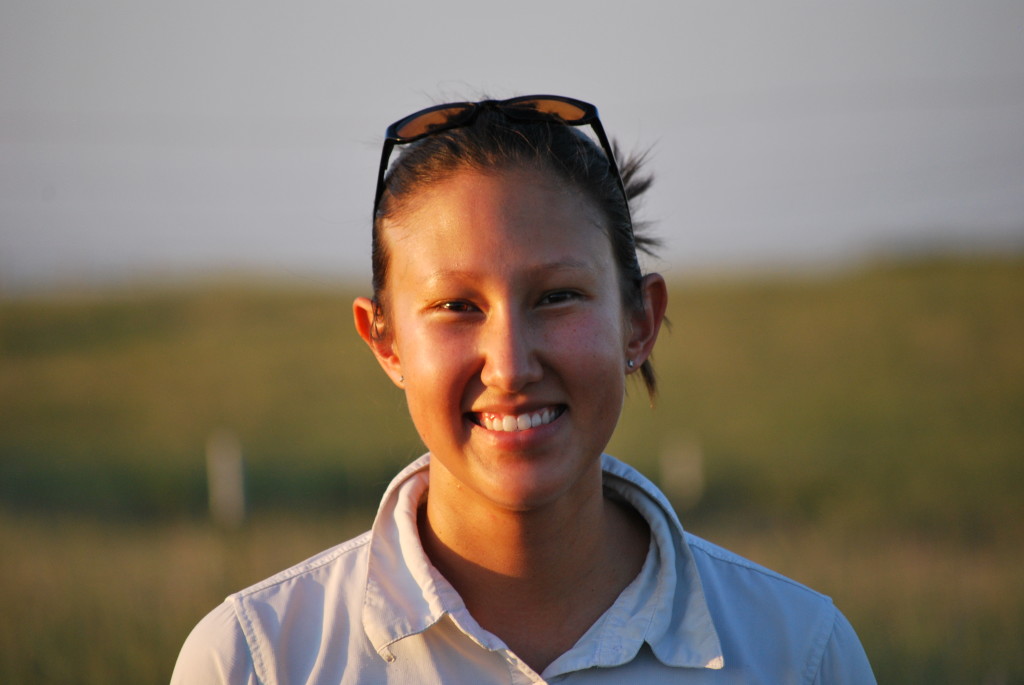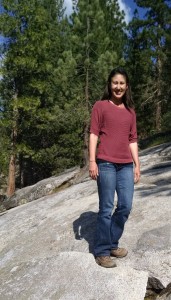by Kristen Minogue

Kim Komatsu in Konza Prairie, Kansas, home to one of the first Long-Term Ecological Research (LTER) programs. (Credit: Arjun Potter)
Kim Komatsu does big-picture ecology. The newest senior scientist at the Smithsonian Environmental Research Center, Komatsu is leading the center’s Ecosystem Conservation Lab. But while working on large-scale global experiments, she also delves into the microscopic world of bacteria. In this Q&A, discover how bacteria give certain plants an edge, and how she blends the very large and the very small.
This is the first of three profiles about the young scientists heading SERC’s newest labs. Edited for brevity and clarity.
You’ve done a great deal of work with legumes—plants in the bean and pea family. Can you talk about their weird relationship with rhizobial bacteria?
The [legume] plants and bacteria are in a mutualism where the plants fix carbon into sugar and give it to the bacteria, and the bacteria are able to take nitrogen from the atmosphere and give it to the plants. This is a source of nitrogen that no other plants have access to. Most plants have to take [nitrogen] up from the soil. Because of this mutualism, legumes can get nitrogen from another source, and that often makes them very successful in different, especially harsh environments….
It’s interesting to think about the different legume species, and how good they are at enforcing cooperation from the bacteria. Thinking about the bacteria as not only potentially being beneficial, but [also possibly] cheating the system—trying to take carbon from the plants and not give back as much nitrogen, especially under high soil nitrogen conditions.
Why do you find these microbe relationships so exciting?
It’s something that people haven’t really thought about a lot in the past—what’s below your feet, you can’t see it. We don’t have X-ray vision. Particularly thinking about microbes, even though they’re aboveground and belowground, you can’t see them without a microscope. I think it’s exciting to delve into these worlds that no one has thought too much about before because we haven’t really had the technology to easily study them. And now we definitely can.
What kind of bacteria research would you like to do at SERC?
Here at SERC, I’m really interested in thinking about how bacteria are dispersing within the environment and what their population or community structure is across the landscape. Is it really uniform, that all kinds of bacteria are everywhere, or are they really patchy? Are they at really low abundances, and waiting for [the right conditions] to come along and amplify their abundances in the soil? Or are they even dispersing from off the SERC property in dust or wind or on people’s shoes? We have very little idea about how bacteria get around. So that’s something that I plan to focus on here.
How do you search for bacteria in the field?
A lot of it is taking soil samples or digging up plant roots, and then bringing them back to the lab. From the root samples you can culture bacteria, and from the soil samples you can do whole-soil sample sequencing to get DNA that then you could match with other known bacteria….The types of bacteria I work with, Rhizobia, all look like white blobs when you culture them. You can’t really tell what species there are. I use molecular tools to figure out who I’m looking at.

Kim Komatsu on an outcrop by Hume Lake, in her home state of California. (Credit: Cathy La Pierre)
You’ve been working on a synthesis of 101 long-term projects from all around the world, two at SERC’s Global Change Research Wetland. What is that about?
We’re really interested in thinking about how plant communities are changing in response to global change factors. So we gathered a bunch of datasets from experiments that have manipulated resources or other global change factors…
It seems like the more factors that are simultaneously manipulated, the bigger the community response, but there’s a threshold. If you manipulate one, two, three or four factors simultaneously, there’s really no community change. But once you manipulate five factors, there’s a huge community response. And we have no idea why that is.
How would you explore that more deeply at SERC?
I really think we need, as a scientific community, to have more multiplicative global change experiments. Because we know that global change in the world is not happening in isolation—just CO2 increases or just temperature changes. It’s all together. So that’s something else that I plan to work on here at SERC, getting more of these really big experiments going.
You’re from the San Francisco Bay region. Are there any areas of overlap between what you’ve studied in California and what you’ll be studying here in the Chesapeake?
I think every place in the world has the same environmental issues. So when thinking about conservation of ecosystems, it’s really important to find the commonalities among many different systems around the world. And if there are differences, identify why there are differences….We know there are plants everywhere; there are bacteria everywhere; there are insects everywhere. What are the relative strengths of the interactions between these species at different sites? How those different interactions and suites of species respond differentially to global change factors is important to help drive overall conservation efforts.
Meet more of SERC’s new generation of lead scientists:
Q&A: Katrina Lohan, Marine Parasite Hunter
Q&A: Ian Davidson, Aquatic Inquirer

